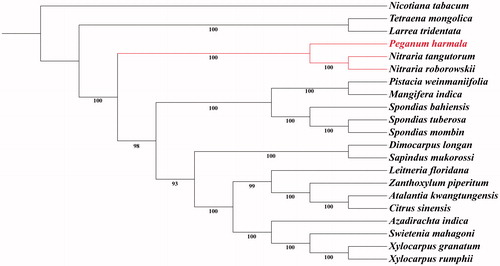Abstract
Peganum harmala is the representative species of Peganum mainly growing in saline soils in temperate deserts and Mediterranean regions. Here, we report the complete chloroplast genome sequence of P. harmala. The genome was 160,068 bp in length with the GC content of 37.5%. The genome encoded 127 genes including 82 protein-coding genes, 37 tRNA genes, and 8 rRNA genes. The phylogenomic analysis suggested that P. harmala forms a monophyletic group with Nitraria, which supported to divide Peganum and Nitraria from Zygophyllaceae as Nitrariaceae.
Peganum harmala, belonging to Nitrariaceae, is a perennial, herbaceous plant, and mainly distributed in North Africa, Europe, and Asia. The distribution in China is considered to be native to slightly saline sands near oases and dry grasslands in desert areas of northwest China (Wu et al. Citation2008). Peganum was first placed in Zygophyllaceae, but the systematic position of Peganum was altered by recent molecular-phylogenetic studies (Sheahan and Chase, Citation1996). APG III separated Peganum together with Nitraria, and Tetradiclis from Zygophyllaceae and formed a new family Nitrariaceae (The Angiosperm Phylogeny Group, Citation2009). Up to now, there is still a controversy about the phylogenetic status of Peganum with the relative genus and need to be further elucidated. Meanwhile, most researches concerning P. harmala mainly have been focused on its chemical composition, pharmacological activity and little is known about the chloroplast gene of P. harmala. In the present study, we report the completed chloroplast genome of P. harmala based on the next-generation sequencing method. To our knowledge, this is the first completed chloroplast genome of Peganum genus.
P. harmala was collected from Qinghai, China and the specimen was deposited in the Qinghai–Tibetan Plateau Museum of Biology (Voucher specimen: Zhang2018013, HNWP). The genomic DNA was extracted from the fresh leaves with the modified CTAB method (Doyle Citation1987). The complete chloroplast genome was sequenced by the Illumina HiSeq2500 platform (San Diego, CA, USA) and assembled with SPAdes (Bankevich et al. Citation2012), annotated with GeSeq (Tillich et al. Citation2017). Phylogenetic analysis was performed based on complete chloroplast genomes of P. harmala together with two species from Nitrariaceae, two species from Zygophyllaceae, 15 species from Sapindales and Nicotiana tabacum as outgroup., Sequences were firstly aligned by MAFFT (Kazutaka and Standley, Citation2013). Then Gblocks (Castresana Citation2000) was used to remove ambiguously aligned sites. At last maximum likelihood (ML) analysis was conducted on RAxML-HPC2 on XSEDE based on the GTR + G + I nucleotide substitution model.
The complete chloroplast genome of P. harmala (MK347420) has a total length of 160,068 bp with the GC content of 37.5%. Two inverted repeats (IR, 26,469 bp) were separated by a large single copy region (LSC, 88,278 bp) and a small single copy region (SSC, 18,852 bp). A total of 127 genes were predicted including 82 protein-coding genes, 37 tRNA genes, and 8 rRNA genes, in which 19 genes were duplicated in the IR regions (7 tRNA, 4 rRNA, 8 protein-coding genes). ML analysis showed that the P. harmala forms a clade with Nitraria, which supported the division of Peganum and Nitraria from Zygophyllaceae as Nitrariaceae (). We expect that the chloroplast genome of P. harmala will be a valuable resource for future studies on conservation genetics, taxonomy, and phylogeny involving this particular species.
Figure 1. Maximum likelihood phylogenetic tree based on 21 complete chloroplast genome sequences. Accession numbers: Atalantia kwangtungensis MH329190.1, Azadirachta indica KF986530.1, Citrus sinensis DQ864733.1, Dimocarpus longan MG214255.1, Larrea tridentate KT272174.1, Leitneria floridana KT692940.1, Mangifera indica KY635882.1, Nicotiana tabacum Z00044.2, Nitraria roborowskii MK347421, Nitraria tangutorum MK347423, Peganum harmala MK347420, Pistacia weinmaniifolia MF630953.1, Sapindus mukorossi KM454982.1, Spondias bahiensis KU756561.1, Spondias mombin KY828469.1, Spondias tuberosa KU756562.1, Swietenia mahagoni MH348156.1, Tetraena mongolica MH325022.1, Xylocarpus granatum MH348155.1, Xylocarpus rumphii MH330687.1, and Zanthoxylum piperitum KT153018.1.

Disclosure statement
No potential conflict of interest was reported by authors.
Additional information
Funding
References
- Bankevich A, Nurk S, Antipov D, Gurevich AA, Dvorkin M, Kulikov AS, Lesin VM, Nikolenko SI, Pham S, Prjibelski AD, et al. 2012. SPAdes: a new genome assembly algorithm and its applications to single-cell sequencing. J Comput Biol. 19:455–477.
- Castresana J. 2000. Selection of conserved blocks from multiple alignments for their use in phylogenetic analysis. Mol Biol Evol. 17:540–552.
- Doyle JJ. 1987. A rapid DNA isolation procedure for small amounts of fresh leaf tissue. Phytochem Bull. 19:11–15.
- Kazutaka K, Standley DM. 2013. MAFFT Multiple Sequence Alignment Software Version 7: improvements in performance and usability. Mol Biol Evol. 30:772–780.
- Sheahan MC, Chase MW. 1996. A phylogenetic analysis of Zygophyllaceae R.Br. based on morphological, anatomical and rbcL DNA sequence data. Bot J Linn Soc. 122:279–300.
- The Angiosperm Phylogeny Group. 2009. An update of the Angiosperm Phylogeny Group classification for the orders and families of flowering plants: APG III. Bot J Linn Soc. 161:105–121.
- Tillich M, Lehwark P, Pellizzer T, Ulbricht-Jones ES, Fischer A, Bock R, Greiner S. 2017. GeSeq - versatile and accurate annotation of organelle genomes. Nucleic Acids Res. 45:W6–W11.
- Wu ZY, Raven PH, Hong DY. 2008. Flora of China: Vol. 11. St. Louis (MO): Missouri Botanical Garden.
